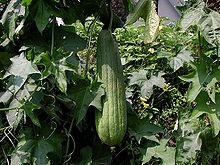Every year, I try to grow something I have not grown before. Loofahs were my experiment this year.
Some people mistakenly think that these scratchy, buff-colored scrubbers are a cousin to sea sponges. Often found in natural food stores and spas, loofahs are actually a member of the Cucurbitaceae family, along with squashes, cucumbers, melons and gourds. “Sponge gourd” is a common name for loofah (also spelled luffa).
Six species of loofah have traditionally been used for food and sponges. Although all species have edible blossoms and fruit that is edible when immature, before it becomes fibrous, only two species are generally cultivated. Luffa acutangula, sometimes called Chinese okra and occasionally seen on Asian menus, is long and ridged.
For the table, it is harvested young, like a summer squash. Maybe next year I will try that one.
But this year, I grew Luffa aegyptiaca, the sponge loofah, because the seed packet intrigued me. It showed a beautiful green vine with small, shiny, dangling melon-like fruits. An image of the harvested loofahs made them look like they would easily fit in your hand, just the right size for scrubbing dishes. Visions of homegrown loofahs tied with bright bows for holiday gifts filled my imagination.
The size of the seeds should have given me a clue. They were shiny and dark, like extra-large watermelon seeds. For one of the loofahs growing in my garden to fit in my hand, I will have to cut it into five pieces.
Loofahs need a long growing season, so I started the seed in April. I soaked the seeds for a day, then planted them in small pots rather than directly in the ground as I knew these heat-loving plants would need a jumpstart. I watered them every few days to keep the seedling mix moist but not soaking wet.
When the first true leaves appeared, it was time to transplant. I took care to be gentle. Although the plants are still small, their roots can be up to six inches long and do not like being disturbed.
In early May, I chose a spot in the garden that got full sun and worked compost into the soil there. I erected a tall wire cage and planted the seedlings about a foot apart all around the cage. I mulched with compost and installed drip emitters. I protected the seedlings from slugs and birds until they were established, but after that, the plants were relatively pest-free.
Loofahs grow quickly into rambling vines with rapidly developing leaves and tendrils. Large, bright yellow blossoms soon appear. Our garden pastime this year was watching the shiny black bumblebees and carpenter bees diving into the golden pollen in the center of the abundant loofah flowers. With so much pollinating activity, we were surprised that it took so long to finally see a baby loofah.
That first loofah quickly grew to resemble a long cucumber. The surprise was that, unlike a firm cucumber, this fruit was squishy and soft.
Like their cucurbit relatives, loofahs are annuals. They perform much better supported by high trellises or cages than sprawled on the ground. Trellising keeps them cleaner and away from some pests, and the loofahs grow straighter than they do without a trellis.
Over the next few months, my loofah vines continued to fill in and flower abundantly, attracting more and different bees, wasps and flies. But it took a long time before more fruit appeared. Just a few weeks ago, we started noticing more “babies.”
Now that the weather is turning, we have several mature loofahs, a good selection of probably harvestable sponges, and a bunch of babies that are clearly not going to mature before the season ends. Maybe we will cook a few of those.
Loofahs are harvested when the peel is easy to remove from the spongy skeletal fibers beneath. Pick them when they start to feel light and turn from green to tan or yellow. The skin should feel loose and thin and peel off easily. Shake out the seeds. Leave sponges whole, or cut them smaller. If you harvest them before the autumn rains arrive, they will be a lighter and more regular color. Rain can darken and discolor them.
I plan to grow loofahs again next year, but for now, I am looking forward to peeling the skin from this year’s fruits and revealing the sponge within.
